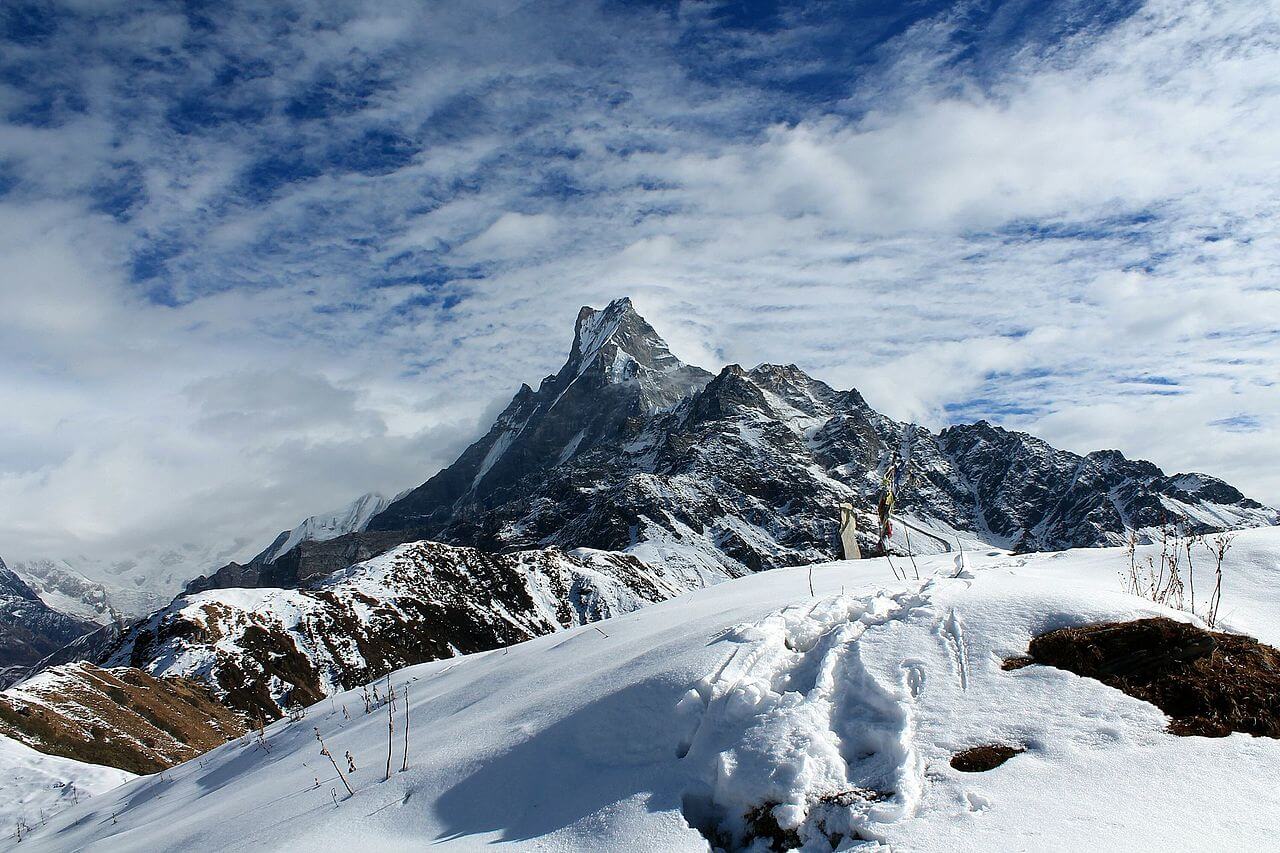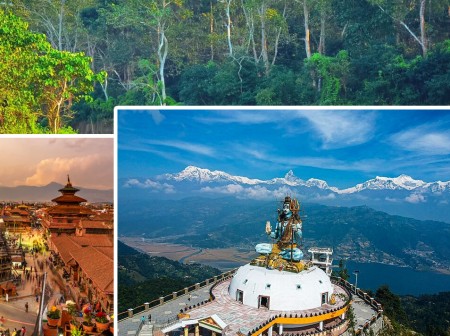
Best Season for Mardi Himal Trek
- soleencounters
Introduction
Nestled in the Annapurna region, the Mardi Himal Trek offers one of Nepal’s most scenic short trekking experiences. Known for its peaceful trails, stunning mountain views, and authentic local charm, this trek is a favorite among adventure lovers.
Table of Contents
Timing is crucial for your trekking experience. From clear mountain views to blooming rhododendron forests, the best season for the Mardi Himal Trek can make your journey truly special. In this guide, we’ll look at the ideal times to trek, what each season offers, weather patterns, and local tips from experts at Sole Encounters Trekking Pvt. Ltd. to help you plan your adventure.
Understanding the Mardi Himal Trek
The Mardi Himal Trek is situated east of the popular Annapurna Base Camp Trek route. It provides an off-the-beaten-path experience with panoramic views of Machhapuchhre (Fishtail), Annapurna South, and Hiunchuli. This trek usually takes 5 to 7 days and reaches Mardi Himal Base Camp at 4,500 meters.
Unlike crowded trails, Mardi Himal offers a peaceful environment, allowing for a closer connection with nature and the local Gurung culture. Its moderate difficulty and short length make it suitable for beginners and experienced trekkers alike.
Best Season for Mardi Himal Trek – Overview
Nepal has four main trekking seasons: Spring, Summer (Monsoon), Autumn, and Winter. Each season brings a different experience in terms of weather, visibility, flora, and trail conditions.
|
Season |
Months |
Weather & Visibility |
Highlights |
|
Spring |
March – May |
Mild & colorful |
Rhododendron blooms, clear skies |
|
Summer (Monsoon) |
June – August |
Wet & humid |
Lush greenery, leeches on trails |
|
Autumn |
September – November |
Stable & dry |
Best mountain visibility |
|
Winter |
December – February |
Cold & crisp |
Fewer trekkers, snow views |
The best times for the Mardi Himal Trek are Spring (March to May) and Autumn (September to November). These seasons offer the most comfortable weather, safe trails, and rewarding views of the Himalayas.
Mardi Himal Trek in Spring (March to May)
Weather Conditions
Spring in Nepal brings warm days and mild nights. The lower regions feel comfortable, while higher altitudes are cool and pleasant.
- Daytime Temperature: 10°C to 20°C
- Night Temperature: 0°C to 5°C
Expect mostly clear skies, providing excellent views of the Annapurna and Machhapuchhre ranges. Occasional clouds or light rain showers may appear toward late May.
Highlights of Spring Trek
- Forests filled with vibrant rhododendron blossoms, especially around Forest Camp and Low Camp.
- Clear visibility of snow-capped peaks.
- Pleasant temperature for hiking without extreme heat or cold.
- Moderate crowds, making it popular but not overcrowded.
Tips for Spring Trekkers
- Book teahouses early during the busy April season.
- Pack light layers for the mornings and evenings.
- Prepare for more photographers on the trail due to the stunning floral landscapes.
Spring is ideal for those who want a colorful and lively trekking experience with great weather and stable conditions.
Mardi Himal Trek in Summer/Monsoon (June to August)
Weather Conditions
The Monsoon brings frequent rain, making trails slippery and muddy.
-
- Daytime Temperature: 15°C to 25°C
- Night Temperature: 5°C to 10°C
- Rainfall: High humidity with daily showers, mainly in the afternoons.
Although mountain views can be obscured by clouds, the landscapes are green and filled with fresh vegetation.
Highlights of Summer Trek
- Beautiful greenery and blooming wildflowers.
- Quiet trails, as very few trekkers venture during this time.
- Great for those seeking solitude or experienced trekkers comfortable with wet conditions.
Challenges and Tips
- Leeches can be common on lower trails; use salt or insect repellent.
- Avoid trekking in the afternoons due to slippery trails and heavy rain.
- Waterproof gear is a must. Bring a rain jacket, backpack cover, and proper boots.
While not ideal for beginners, the Monsoon season offers a unique perspective—peaceful, lush, and teeming with nature’s energy.
Mardi Himal Trek in Autumn (September to November)
Weather Conditions
Autumn is often considered the best season for the Mardi Himal Trek. The monsoon rains clear the air, leading to stable weather and excellent mountain visibility.
- Daytime Temperature: 10°C to 20°C
- Night Temperature: 0°C to 5°C
This season strikes a perfect balance of clear skies, comfortable temperatures, and dry trails.
Highlights of Autumn Trek
- Spectacular sunrise views from Mardi Viewpoint and High Camp.
- Crisp weather with clear visibility of the Annapurna and Dhaulagiri ranges.
- Local cultural festivals like Dashain and Tihar, enhancing the cultural experience.
- Best time for photography, offering sharp contrast and golden light.
Tips for Autumn Trekkers
- Trails tend to be busier; pre-book your accommodations.
- Bring warm clothes for the early mornings and higher altitude sections.
- Enjoy local homestays or teahouses to experience Gurung hospitality.
Autumn is perfect for those who want a blend of natural beauty, comfortable weather, and cultural richness.
Mardi Himal Trek in Winter (December to February)
Weather Conditions
Winter trekking offers crisp air, peaceful trails, and snow-dusted peaks.
- Daytime Temperature: 5°C to 10°C
- Night Temperature: -5°C to 0°C
- Expect snowfall above High Camp or Base Camp in January and February.
Highlights of Winter Trek
- Stunning views of snow-covered mountains.
- Fewer trekkers mean you can enjoy solitude and a quiet mountain ambiance.
- Teahouses stay open at lower camps like Forest Camp and Low Camp.
Challenges and Tips
-
- Very cold mornings and nights; pack thermal layers and a warm sleeping bag.
- Some teahouses at High Camp may close temporarily due to snow.
- Trekking poles and microspikes can be handy for icy trails.
Winter is best for experienced trekkers who enjoy peaceful, snowy adventures.
Comparing the Seasons: Which is Best for You?
|
Preference |
Best Season |
|
Clear mountain views |
Autumn / Spring |
|
Fewer crowds |
Winter / Monsoon |
|
Colorful landscapes |
Spring |
|
Cultural experiences |
Autumn |
|
Adventure & solitude |
Winter |
If your goal is stunning views and comfortable trekking, opt for Spring or Autumn. If you prefer quiet trails and a unique challenge, Winter will give you a peaceful experience.
Conclusion
The best season for the Mardi Himal Trek ultimately depends on what you want vibrant blossoms in Spring, clear views in Autumn, peaceful snow in Winter, or lush landscapes during Monsoon. Each season reveals a unique character of the Himalayas.
For most trekkers, Autumn (September to November) and Spring (March to May) offer the best mix of weather, scenery, and comfort. Plan your trek with Sole Encounters Trekking Pvt. Ltd., and let our local experts help you pick the perfect time for an unforgettable Himalayan journey.
Recent Posts
.jpg)
3rd Jul, 2025
.jpg)
4th Jul, 2025
.jpg)
4th Jul, 2025
.jpg)
7th Jul, 2025
.jpg)
8th Jul, 2025
.jpg)
8th Jul, 2025
.jpg)
8th Jul, 2025

10th Jul, 2025








